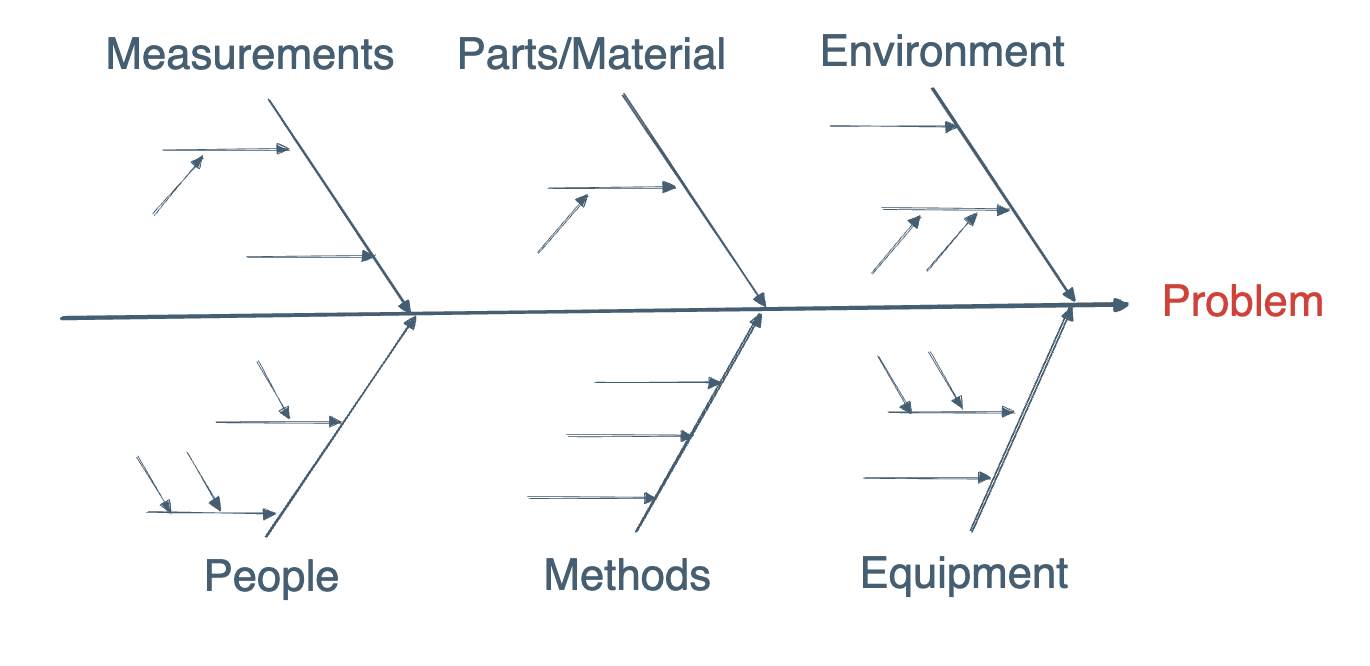Fishbone Analysis
A Fishbone Diagram (also called an Ishikawa Diagram) is a tool commonly used in manufacturing to help with root cause analysis. Manufacturing is a complex system, and applying a common structure to your problem solving can help you understand and avoid missing any root causes as you work to correct them.
An example is below, and if you squint you can see why it’s called a fishbone… because if you squint, kind of looks like a set of fishbones. Coming off of the main “problem” line are 6 primary causes of issues in Manufacturing. Sometimes these will be labeled slightly different but for now we’ll call them Measurements, Parts/Material, Environment, Equipment, Methods, and People. Any issue you come across when manufacturing will likely fall into one of these categories, and you can then list potential causes (and any further upstream causes) explicitly on the fishbone.
An example of a fishbone diagram template

When doing a fishbone diagram, it’s helpful to actually write it out on a large piece of paper or a whiteboard, and then do a 5 Why’s exercise as you discuss the problem to identify any other “bones” on the diagram that need to be specified. If you haven’t heard of the 5 Why’s, its’ pretty self-explanatory: When discussing an issues asky “Why?” 5 times to get to the bottom of what’s happening. While it can be abused by toddlers to annoy their parents, it’s also a very effective tool in getting to the root cause
“Why are we behind schedule?” - Yield is at 70%, we’re building enough we just aren’t building enough good parts “Why is yield so low?” - We have a lot of surface defects “Why are there surface defects?” - we just changed tools, and there’s a lot of chatter in the equipment “Why is their chatter?” - The belts are loose “Why are the belts loose” - We skipped a step and didn’t validate and sign-off the tool before going live.
So there’s your answer - in this instance the team needs to make sure the tool is working properly before releasing to production. It’s a simple example, but the difficulty in manufacturing is usually not each individual item, it’s understanding how the whole system is working and what can be done to increase productivity and profitability, and making a fishbone diagram can help you organize your data in an approachable way.
With Threaded, we’ll help you understand when an exercise like this may be helpful, and then create, track, and collaborate on actions with your team to drive solutions to root causes as they are identified.
If you want to learn more about fishbone analysis and how it can help your team solve problems, check out this article on lean.org.
Learn how Threaded’s AI Assistant can help you identify root causes and suggest corrective actions in our AI Assistant Guide.



